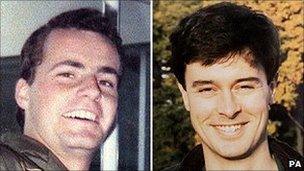New doubt cast over Mull of Kintyre Chinook crash cause
- Published

29 people were killed when the Chinook helicopter crashed on the Mull of Kintyre in June 1994
Newly discovered Ministry of Defence documents have cast further doubt on the cause of the Chinook helicopter crash on the Mull of Kintyre in 1994.
The papers, obtained by the BBC, suggest there were official concerns over the airworthiness of the RAF's fleet of Chinooks two years earlier.
It is understood they were never shown to the officer in charge of signing off the aircraft's airworthiness.
Twenty-nine people were killed on the flight from Belfast to Inverness.
They included 25 of Northern Ireland's most senior intelligence experts and four special forces crew.
Lord Alexander Philip is heading up a review into the cause of the crash and is due to report to the defence secretary in the summer.
Both the MoD and a spokesman for Lord Philip's review said it would be "inappropriate" to comment at this stage.
The documents have never been made available to any previous probe into the accident, including the fatal accident inquiry, the BBC understands.
In 1992 the RAF set up a Chinook Airworthiness Review Team, led by a wing commander engineer, because of concerns about safety and maintenance standards, the papers show.
The subsequent report said five previous crashes over six years had called into question the effectiveness of the aircraft's overall "management and maintenance".
Experts believe the paper shows that "systemic failings" blamed for an RAF Nimrod crash in Afghanistan in 2006 may have been ingrained in the MoD before the 1994 Mull of Kintyre crash and could have been a factor in that accident.
'Kept secret'
A new independent report, written by aviation experts, has now been submitted to Lord Philip's review which backs up that view.
Captain Ralph Kohn, one of the authors, told the BBC: "When we read it we were amazed at the parallels that it established between our report and what the RAF had found for itself but kept secret."
Campaigners say the 1992 documents prove the two Chinook pilots, Flight Lieutenants Jonathan Tapper and Richard Cook should never have been blamed and should now be cleared.
Dated in August of that year, the Chinook Airworthiness Review Report (Chart) stated: "Since entering RAF service in 1980, the Chinook HC Mk 1 has been dogged by configuration control problems, inadequate publications and system unreliability.
"Throughout, the Chinook has been regarded by maintenance staffs as a "Cinderella" of the RAF fleet.
"Five accidents over the past six years, and serious incidents such as uncommanded flying control movements have brought into question the effectiveness of the [aircraft's] overall management and maintenance."
The report goes on to detail some of the accidents, including one in the Falkland Islands in February 1987 which "pitched nose down from about 300ft [91m] and impacted the ground, killing the occupants."

Flt Lt Cook, left, and Flt Lt Tapper were blamed for the crash
It says the cause was "never fully determined."
The papers talk of a "wide range of Chinook airworthiness issues concerning both present HC Mk1 and the future Mk 2 Chinooks."
It was a Mk 2 helicopter which crashed into the Mull of Kintyre in 1994.
The updated version of the aircraft also had on board the much criticised FADEC engine software which MoD engineers described, in documents obtained last year, as "positively dangerous".
The FAI and original RAF Board of Inquiry did not apportion blame for the Mull of Kintyre crash.
'General pattern'
But in 1995 two RAF air marshals subsequently blamed the pilots for "gross negligence".
The air marshals - Sir William Wrattan and Sir John Day - are believed to have been questioned by Lord Philip and his panel within the past few months.
Sir Donald Spiers was Controller Aircraft in 1994 and the MoD official who signed the airworthiness certificate for the Mk 2 Chinook.
Capt Kohn said: "I would have thought that had he signed it after seeing this report, I could only describe him as irresponsible."
In a statement, Sir Donald said he was not prepared to comment given Lord Philip's review into the crash.
However, he said the CHART report was not relevant to the airworthiness of the Mk 2 aircraft since it was concerned with the Mk 1 Chinook and was written two years before the updated helicopter entered service.
Air Commodore John Blakeley has campaigned for the verdict against the pilots to be overturned.
He said it was "extremely surprising" the Chart report was not drawn to the attention of the RAF Board of Inquiry.
But he added it was part of a "general pattern".
"It's one of a series of documents that we have now seen that I believe would have potentially caused the board of inquiry to come to a different conclusion and would have caused the reviewing officers not to move from a 'we don't know' conclusion to the 'gross negligence' verdict, which we started the fight against," he said.
In 2009 a highly critical report by Sir Charles Haddon-Cave into the crash of the RAF Kinloss-based Nimrod in Afghanistan blamed "systemic failings" within the MoD and accused it sacrificing safety to cut costs.
Capt Kohn said the latest document showed that many other accidents may have been caused by airworthiness standards.
"You realise when you look at the Chart report, we are talking of problems that go back to 1980 and probably earlier," he added.
"We could find examples of similar errors and faults and failings. We are talking of a Hercules, of Pumas, of a lot of different aeroplanes in the RAF that have had crashes and failings."
- Published12 April 2011
- Published16 September 2010